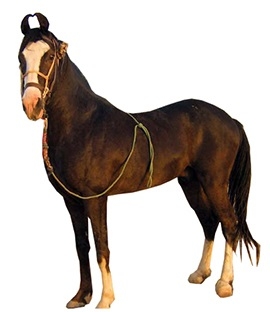
General Information
The breed is made from wild horses of Kathiawar. It is found mainly in districts of Gujarat such as Amreli, Bhavnagar, Rajkot, Sundernagar and Junagarh. The Kathiawari breed has chestnut, bay, grey and dun coat colours but among these colours, dun colour is found most commonly. They have small heads, broad foreheads, narrow ears, stout necks, slopping shoulders, short backs, long legs and shining coats. Horses are 119cm long and are 147cm in height. This breed has 15cm ear length, 53cm face length and 160cm heart girth.
Fodder
Horse needs food that is healthy, nutritious and satisfies their hunger needs. They love to eat sprouts of cereal grain. They will love to eat a variety of cereal grain sprouts such as barley sprouts. Mainly barley sprouts are used as it has excellent nutritious value and sprouts early. The protein level of barley sprouts is between 16-18%. The barley is easily digestible by horses and has a high moisture content. For good performance of horses sunflower seeds in small amounts are given to the horse as it will increase protein levels in their body. Only fodder is not sufficient in the horse diet. Along with fodder, dry roughage is also given to complete horse feed. The diet is given to the horse approximately 2% of the horse’s body weight. Grain hays and grass hays are best in the feed diet.
Care of the breed
For horse farming, suitable land that has a barn or shed and open space should be selected. They require shelter or a shed which will help the horses to save them from wind and rainfall. Ensure that clean air and water facility should be there in selected land. In winters, the horses are kept in a shed or a horse blanket is given to protect them from cold weather and in summers, shade is necessary. To cover the land from ends, fences are required.
Care of pregnant mares: Breeding is mainly done in mid-late spring and when the male horse is at least 4 years old and the female horse is 5-6 years old. After breeding, the gestation period remains for an average of 340 days and they give birth to 1 foal. It is expected that the mare will gain its weight up to 9-12% of her body weight. High-quality alfalfa or grass is given to the mare during the pregnancy stage. To complete the need for calcium in the mare’s body, a supplement of salt-calcium-phosphorus mix is given in the feed.
Care of newborn horse: Immediately after birth check the breath of the foal. If the foal is not taking a breath, rub the foal vigorously or blow the air into the foal’s mouth. This will help to stimulate the respiratory system. Do not immediately cut the umbilical cord as it will help the foal to receive blood from the mare. Clean the umbilical stump with 1-2% of iodine.
Care of mare after delivery: The mare needs to be checked thoroughly. Good quality hay should be given to relax the mare. Protein and calcium content must be given in the diet. Deworming should be done by giving ivermectin. Along with protein and calcium, Vitamin A and D must be given in the diet.
Recommended vaccines: Updated vaccines as well as de-living every time is required to maintain horse good health. Equine influenza vaccination is required for horse health. Some vaccines such as deworming are required once every year. Some major vaccines or medicines that are required for maintaining a horse’s good health are as follows:
• Tetanus injection is given first in 3-4 months and second after 4-5 months of the first dose.
• Three doses of WEE and EEE are given to control the risk of Equine influenza.
• Two vaccinations are given once in 4-6 months and then after 1 month of the first dose to cure the risk of West Nile Virus.
• Three doses of Toxoid vaccination are given when the foal is 2-3 months old at the intervals of 30 days.
• One dose is given when the foal is 6-12 months old to cure Equine Viral Arteritis.
Diseases and Treatment
•Tetanus (lockjaw): The disease is caused by Clostridium botulinum bacteria. The disease is mainly caused by some injury or surgical operation.
Treatment: Tetanus injection is a must once a year to prevent tetanus disease in horses.
•Arthritis: The disease mainly occurs as the horse or pony gets older. The disease causes joint inflammation, fluid levels increase near the joints and visible swelling occurs. As a result horse shows discomfort and is in excessive pain.
Treatment: Firocoxib is an oral paste that is used to treat arthritis.
•Equine rhabdomyelosis (Azoturia): The syndrome causes damage to muscle tissue. It is mainly caused due to vitamin deficiency or poor conditions of the horse. The horse shows painful muscles, stiffness and awkward gait as symptoms.
•Distemper/ Strangles: It is a respiratory infection mainly caused by bacteria. The symptoms are runny nose, fever and loss of appetite.
Treatment: The vaccination of a horse once a year is necessary to cure Strangles.
•Equine influenza: It is a respiratory infection mainly caused by a virus. The symptoms are runny nose with white mucus, cough, loss of appetite and depression.
Treatment: Vaccination of influenza is given twice a year to cure Equine influenza.
•Rhino pneumonitis: It is an upper respiratory disease mainly caused by a virus. The symptoms are cold, cough, runny nose and fever.
Treatment: Vaccination of Rhino pneumonitis is given twice a year to cure this disease.
•Equine Encephalomyelitis: The disease is caused by a virus. The disease mainly damages the brain and can be fatal. The symptoms are fever, excitability and then depression and drowsiness. After some time the horse gets paralyzed and then dies within 2-4 days.
Treatment: In northern areas, the vaccine is given once a year and in warmer or humid regions boosters are given at intervals of 3-6 months.
•Rabies: The disease is mainly transmitted by biting or infection from another animal that is infected by rabies. The symptoms are unusual personality or behaviour change, depression and lack of coordination.
Treatment: Vaccination for rabies is done once a year to get a cure for this disease.\
•Intestinal worms: Mainly horses have intestinal worms which are cured by regular deworming.
Treatment: Deworming medicines are given to cure worms. In wetter areas it is given at the interval of 1 month and in desert areas it is given at the interval of 3 months.
•Colic: Colic itself means belly pain which causes minor to major pain. The disease is caused by worms, spoiled feed and gas. The symptoms are lethargy, lying down and biting at the stomach.
Treatment: Worming of the horse helps to minimize ingestion. Feed the horse bran mash or beet pulp regularly to prevent colic disease.
•Laminitis: The disease is caused due to overeating grain or by overeating lush grass.
Treatment: Remove the grain from the feeder immediately with the help of a veterinarian.
Financial and Business expert having 30+ Years of vast experience in running successful businesses and managing finance.





